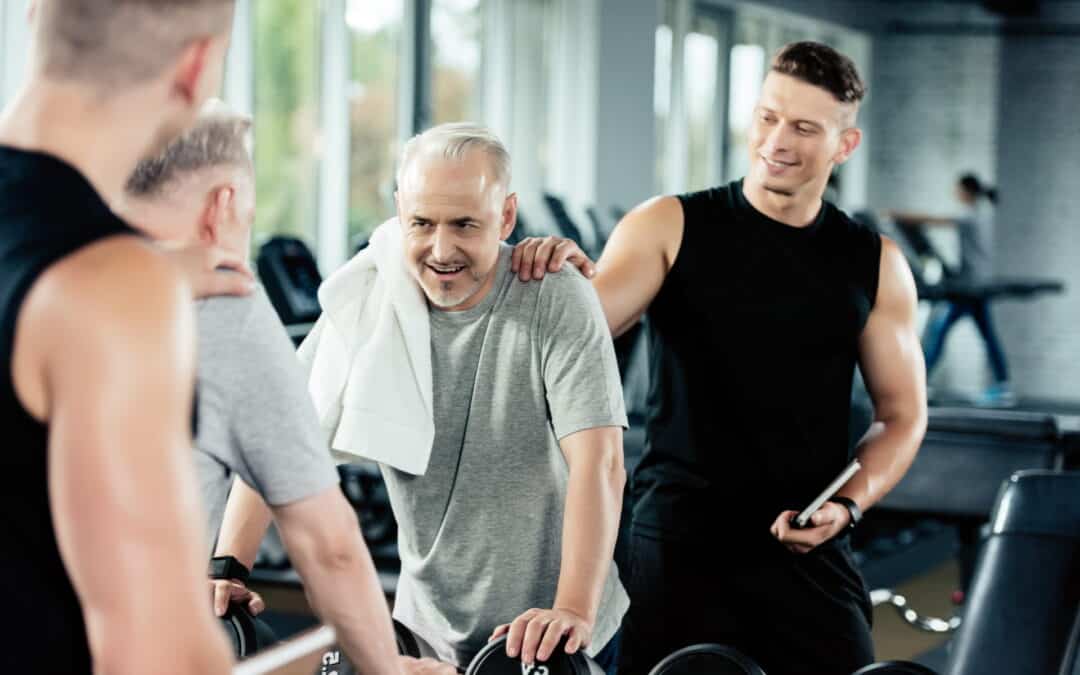As men age, their physical needs change, often requiring adjustments to their fitness routines that cater specifically to their evolving bodies. This article explores why men over 50 particularly need tailored fitness programs that account for age-related changes and past lifestyle factors, such as demanding physical work, high-stress environments, and earlier unhealthy lifestyle choices including poor diet, smoking, and alcohol consumption.
Understanding the Physical Changes in Men Over 50
Men over 50 experience a variety of physical changes that can significantly impact their health and fitness. Decreased muscle mass, slower metabolism, and a higher risk of chronic health issues like heart disease and diabetes are common. These changes necessitate a specialized approach to fitness that can help manage and mitigate these effects. For instance, John, a 55-year-old former construction worker, found that regular, tailored workouts helped him regain strength and manage his newly diagnosed type 2 diabetes, demonstrating the profound impact that personalized fitness programs can have.
- Older men often see a reduction in muscle mass, making strength training crucial.
- Metabolism slows down with age, which can lead to weight gain if not managed with appropriate exercise.
- The risk of chronic diseases increases, highlighting the need for cardiovascular and flexibility training.
Role of a Personal Trainer in Tailored Fitness
A personal trainer plays a crucial role in developing fitness programs that are safe, effective, and tailored to the unique needs of men over 50. These fitness professionals assess individual health profiles, including past injuries and existing health conditions, to create customized workout plans that maximize benefits and minimize risks. They also provide the motivation and accountability many men need to stick with their fitness goals.
- Personal trainers create bespoke fitness plans that cater to individual health conditions and fitness levels.
- They teach proper exercise techniques, reducing the risk of injuries.
- Trainers provide motivation and support, crucial for maintaining a long-term fitness regimen.
Addressing Lifestyle Factors Through Fitness
Addressing past lifestyle choices through fitness is crucial for men over 50. Fitness programs tailored for older men often incorporate cardiovascular health, strength training, and flexibility workouts, which can help reverse or manage the effects of years spent indulging in unhealthy habits like smoking, high-fat diets, and excessive alcohol consumption.
- Tailored fitness programs can improve cardiovascular health, reducing the risk of heart disease.
- Regular exercise helps regulate blood sugar levels, which is particularly beneficial for men with a history of poor diets.
- Stretching and flexibility exercises reduce pain and improve mobility, especially for those who may have neglected physical activity in the past.
Exercise Recommendations for Aging Men
It’s vital for aging men to engage in exercises that match their current physical capabilities and health status. Strength training is essential to combat muscle loss, while low-impact cardiovascular exercises like swimming or cycling are effective for maintaining heart health without overtaxing the joints. Regular flexibility exercises, such as yoga or pilates, can also help maintain joint health and mobility.
- Strength training helps maintain muscle mass and supports metabolic health.
- Low-impact cardiovascular exercises protect the joints while improving heart health.
- Flexibility routines enhance joint mobility and reduce the risk of injuries.
Preventing Injuries and Managing Health Conditions
Tailored fitness programs are especially important for preventing injuries in older men. A personal trainer ensures that exercises are performed correctly, significantly reducing the risk of injury. Moreover, these tailored programs can be adjusted to better manage and mitigate existing health conditions like hypertension or arthritis, thus improving overall quality of life.
- Correct exercise techniques are critical to avoid injuries.
- Tailored exercises can be adapted to work around and improve various health conditions.
- Regular assessments by a personal trainer help adapt the fitness program as the individual’s health needs change.
Why Fitness Is Essential for Older Men
Tailored fitness programs for men over 50 are not just about managing weight or looking better—they are essential for maintaining independence, managing chronic health conditions, and improving quality of life. Regular physical activity can help men enjoy their later years with greater health, vitality, and energy.
Key Takeaways: Optimizing Fitness Strategies for Older Men
- Tailored fitness programs are crucial for addressing the specific health and physical challenges that come with aging.
- Personal trainers are invaluable in creating these personalized programs.
- Regular exercise can significantly improve overall health and well-being for men over 50.
Frequently Asked Questions
- What is the first step in starting a fitness program for men over 50?
- Consulting with a health professional and a certified personal trainer to assess your specific health needs and fitness level is recommended.
- How often should men over 50 exercise?
- Men over 50 should aim for at least 150 minutes of moderate-intensity aerobic activity or 75 minutes of vigorous activity per week, along with muscle-strengthening activities on two or more days per week, as advised by health experts.
- Can exercise reduce the risk of chronic diseases in older men?
- Yes, regular physical activity can significantly lower the risk of chronic diseases such as heart disease, diabetes, and osteoporosis.
- Are there any specific dietary recommendations to complement a fitness program for older men?
- A balanced diet rich in fruits, vegetables, lean proteins, and whole grains is recommended. It is also advisable to limit the intake of saturated fats and high-sugar foods.
- What if I have never exercised before?
- It’s never too late to start. Begin with light activities and gradually increase the intensity under the guidance of a personal trainer to ensure safety and effectiveness.

